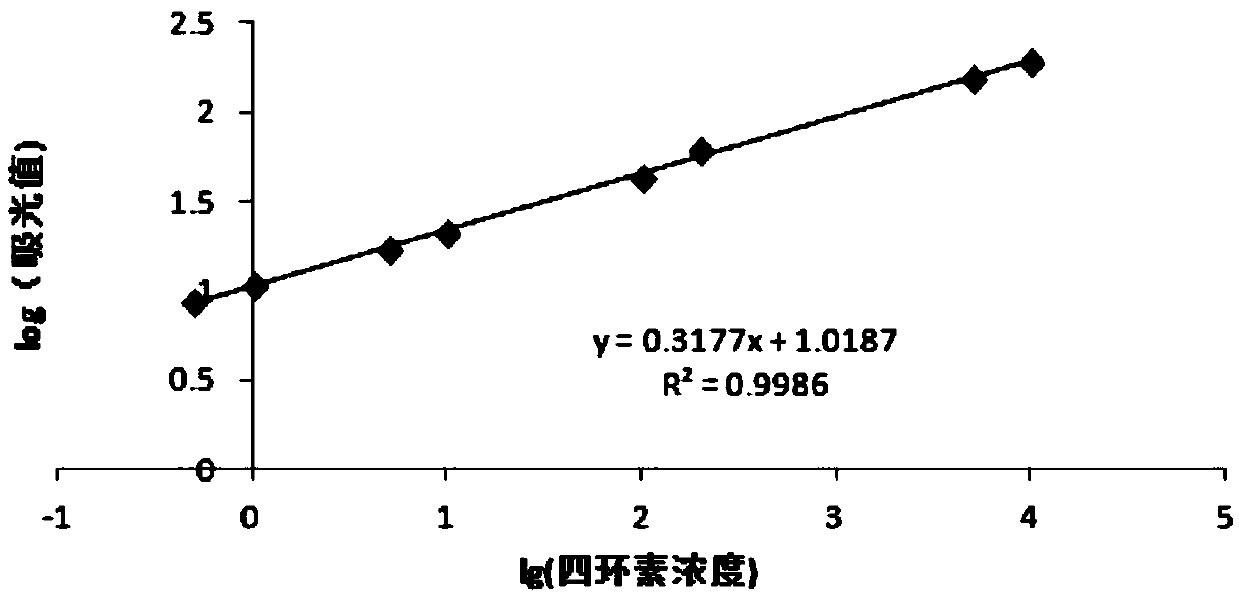Antibiotic detection method based on molecular imprinting-Raman spectrum
A technology of Raman spectroscopy and molecular imprinting, applied in Raman scattering, measuring devices, analysis materials, etc., can solve the problems affecting the efficiency of sample pretreatment and reduce the application value of environmental trace pollutant pretreatment, etc., and achieve short detection time , fast adsorption, good sensitivity
- Summary
- Abstract
- Description
- Claims
- Application Information
AI Technical Summary
Problems solved by technology
Method used
Image
Examples
Embodiment 1
[0036] Step 1, preparation of nano-gold sol: add 4 mL of 1% HAuCl to 120 mL of 4 °C deionized water 4 , stirred, and then added 1mL 0.2mol·L -1 K 2 CO 3 Solution, add 5mL 0.5mg·mL quickly at the end -1 NaBH 4 solution, stirred for 3 minutes, and the obtained wine red nano-gold sol (AuNPs) solution;
[0037] Step 2, PNM-Au composite hydrogel: add 1g N-isopropylacrylamide, 0.2g tetracycline, 15mg sodium hexadecylsulfonate, 15mg cross-linking agent in a flask with condensing reflux and magnetic stirring device A solution composed of N,N-methylene bisacrylamide, 120mL deionized water and 20mL nano-gold sol solution, dispersed evenly under the ultrasonic field, heated to 65°C under the protection of nitrogen flow, and quickly added 8mL ammonium persulfate solution prepared , pour the solution into the mold to react, after the reaction, a film-like gel is formed, after cutting the gel, use electric field dialysis to purify, remove surfactants, unreacted monomers and other subst...
Embodiment 2
[0042] Step 1, preparation of nano-gold sol: add 6 mL of 1% HAuCl to 180 mL of 4 °C deionized water 4 , stirred, and then added 3mL 0.2mol·L -1 K 2 CO 3 Solution, add 10mL 0.5mg·mL quickly at the end -1 NaBH 4 solution, stirred for 6min, and the obtained wine red nano-gold sol (AuNPs) solution;
[0043] Step 2, PNM-Au composite hydrogel: add 3g N-isopropylacrylamide, 0.4g tetracycline, 25mg sodium cetylsulfonate, 25mg cross-linking agent in a flask with condensing reflux and magnetic stirring device A solution composed of N,N-methylenebisacrylamide, 160mL deionized water and 30mL nano-gold sol solution, dispersed evenly under the ultrasonic field, heated to 75°C under the protection of nitrogen flow, and quickly added 12mL ammonium persulfate solution prepared , pour the solution into the mold to react, after the reaction, a film-like gel is formed, after cutting the gel, use electric field dialysis to purify, remove surfactants, unreacted monomers and other substances, a...
Embodiment 3
[0048] Step 1, preparation of nano-gold sol: add 5 mL of 1% HAuCl to 140 mL of 3 °C deionized water 4 , stirred, and then added 2mL 0.2mol·L -1 K 2 CO 3 solution, add 9mL 0.5mg·mL quickly at the end -1 NaBH 4 solution, stirred for 5min, and the obtained wine red nano-gold sol (AuNPs) solution;
[0049] Step 2, PNM-Au composite hydrogel: add 2g N-isopropylacrylamide, 0.3g tetracycline, 20mg sodium cetylsulfonate, 20mg cross-linking agent in a flask with condensing reflux and magnetic stirring device A solution composed of N,N-methylene bisacrylamide, 140mL deionized water and 25mL nano-gold sol solution, dispersed evenly under the ultrasonic field, heated to 70°C under the protection of nitrogen flow, and quickly added 10mL ammonium persulfate solution prepared , pour the solution into the mold to react, after the reaction, a film-like gel is formed, after cutting the gel, use electric field dialysis to purify, remove surfactants, unreacted monomers and other substances, a...
PUM
 Login to View More
Login to View More Abstract
Description
Claims
Application Information
 Login to View More
Login to View More - R&D
- Intellectual Property
- Life Sciences
- Materials
- Tech Scout
- Unparalleled Data Quality
- Higher Quality Content
- 60% Fewer Hallucinations
Browse by: Latest US Patents, China's latest patents, Technical Efficacy Thesaurus, Application Domain, Technology Topic, Popular Technical Reports.
© 2025 PatSnap. All rights reserved.Legal|Privacy policy|Modern Slavery Act Transparency Statement|Sitemap|About US| Contact US: help@patsnap.com



